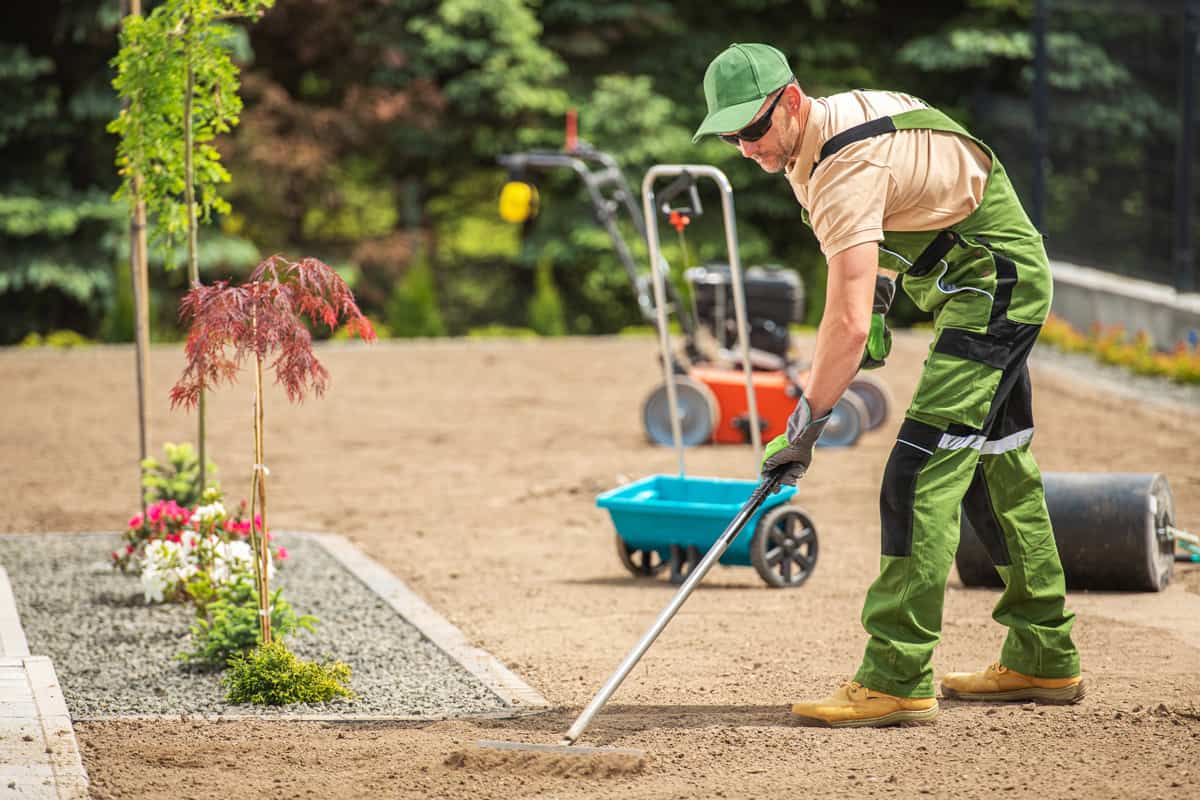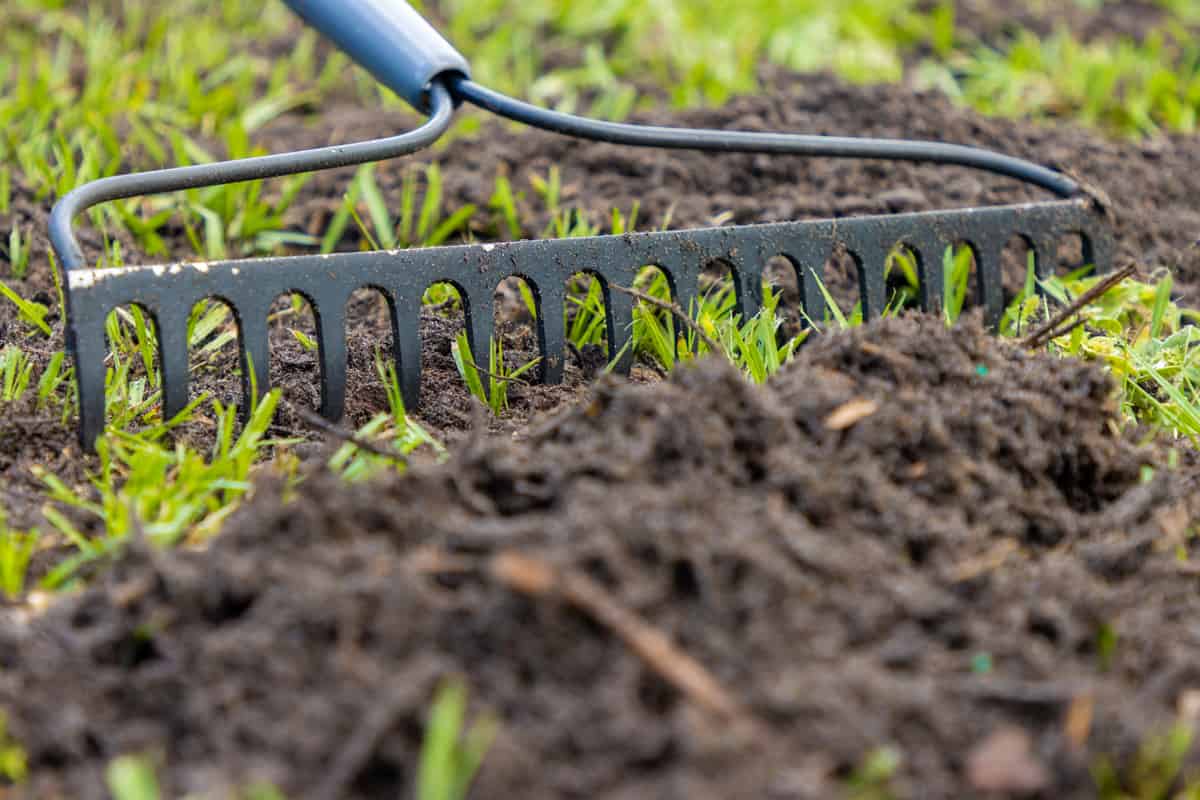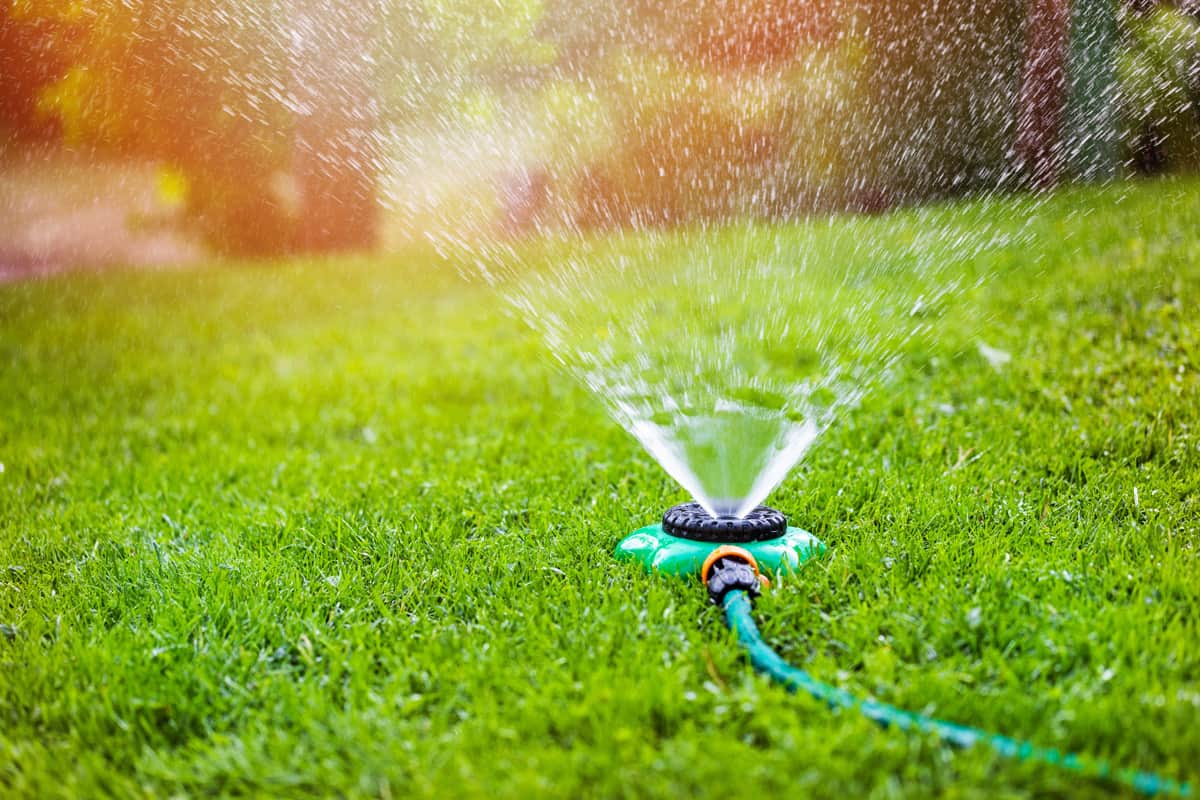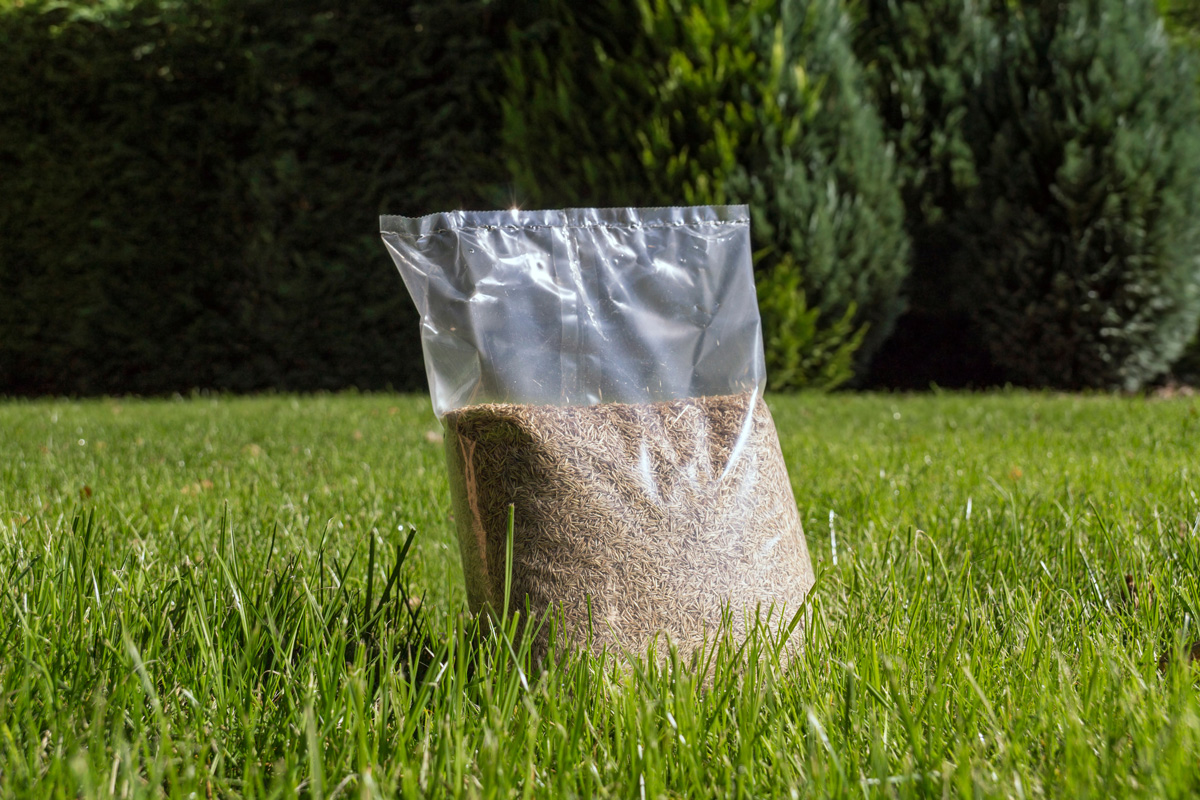Planting grass can be daunting, and raking in the grass seed is a crucial process if you're entirely remodeling your lawn. Want to know how to rake in grass seed? For your benefit, we did some research on this subject, and here’s what we got.
Before entirely raking the grass seeds in, you need to:
- Prepare the site.
- Check the soil pH.
- Dig up any roots, rocks, and clumps.
- Add sand.
- Add compost.
- Balance the soil pH.
- Apply fertilizer.
- Rake the soil.
- Disperse the grass seed.
- Rake in the grass seed.
- Water the lawn.
We'll go into great detail about the processes above in this article. Additionally, we'll discuss different grasses or grass seed options for your garden or lawn. There's more information ahead, so keep on reading!
![regeneration of a damaged lawn - preparation for feeding, How To Rake In Grass Seed? [Step By Step Guide]](https://gardentabs.com/wp-content/uploads/2022/11/22.-How-To-Rake-In-Grass-Seed-Step-By-Step-Guide.jpg)
How Do You Rake In Grass Seed?

Raking in grass seed doesn't require a precise procedure, but there are a few steps you can do to ensure your lawn's success. Unbelievably, the secret to a gorgeous lawn begins long before you rake your grass seed in.
Let's discuss the steps below:
1. Prepare The Site
The most crucial step in seeding a lawn, like most landscaping tasks, is preparation. The soil must be in perfect condition to encourage the tiny grass seeds to germinate.
This calls for the use of well-turned soil with appropriate drainage and chemistry.
You must eliminate any traces of the previous grass to achieve these conditions. You can remove weeds and old grass at their roots using a sod cutter.
Click here to see this sod cutter on Amazon.
2. Check The Soil pH
Shake the plastic test chamber of the test kit well after adding the appropriate amounts of soil and water. Allow the dirt to settle and the color to develop for a few minutes.
Click here to see this test kit for soil pH on Amazon.
Compare the color of the soil solution in the vial to the color-coded chart printed next to the test chamber. The correct range is 6.0 to 7.5.
Your soil is too acidic if the pH reading is less than 6.0, so you must add lime later to neutralize the acidity. The ground is overly alkaline if the pH is higher than 7.5.
Apply later peat moss for moderately alkaline soil and sulfur for highly alkaline soil.
3. Dig Up Any Roots, Rocks, And Clumps
Using a pointed shovel, remove any stones that won't fit between the tines of a garden rake and any visible ones. With topsoil dug up from a high point, fill craters and depressions.
Click here to see this shovel on Amazon.
Till the soil with a rotary tiller until there are no large clumps or areas of compacted dirt. To remove boulders, use a shovel with a fiberglass handle because it won't split or break as easily as one made of wood would.
Click here to see this rotary tiller on Amazon.
See this shovel with a fiberglass handle on Amazon.
4. Add Sand
Sand the planting area to a depth of one inch. Put it in a wheelbarrow and move it to the location. Use a shovel to distribute it as evenly as you can. To blend the sand into the topsoil, use a rotary tiller.
Click here to see this sand soil cover on Amazon.
Click here to see this wheelbarrow on Amazon.
5. Add Compost
Now spread one inch of compost over the surface in the same pattern you did with the sand. Utilize a rotary tiller once more to mix the compost into the sand and soil.
Click here to see this compost on Amazon.
6. Balance The Soil pH
pH balance is achieved in the soil by adding sulfur, lime, or peat moss, which also increases nutrient levels.
Click here to see this lime on Amazon.
Click here to see this peat moss on Amazon.
Using a shovel, distribute peat moss from a wheelbarrow. For lime and sulfur, apply them using a walk-behind broadcast spreader calibrated for the right distribution rate.
Don't overlook any locations as you evenly coat the entire area.
See this walk-behind broadcast spreader on Amazon.
7. Apply Fertilizer
Apply starter fertilizer to the entire area using the broadcast spreader after that. Make that the spreader is set up to distribute fertilizer at the rate specified on the fertilizer box.
Click here to see this starter fertilizer on Amazon.
8. Rake The Soil

We have carefully incorporated the lime (or sulfur) and fertilizer into the top inch of soil using a metal garden rake. Rake the soil to level it out.
Click here to see this metal garden rake on Amazon.
Avoid attempting to distribute fertilizer, lime, or sulfur simultaneously in the spreader or by hand because they must all be applied at different, precise rates.
9. Disperse The Grass Seeds
Use a handheld broadcast spreader to distribute grass seeds over the earth evenly. Take advantage of a walk-behind spreader for larger lawns. Make sure to spread the seed around the area evenly.
Click here to see this handheld broadcast spreader on Amazon.
10. Rake In The Grass Seed
To germinate correctly, the seeds must be in the right conditions, including having good seed-to-soil contact.
The seeds should be positioned about ¼” below the topsoil to avoid erosion and poor germination, and this can be done successfully by raking.
Take a plastic leaf rake, flip it over, and gently work the seeds into the soil using the back of the tines. Use quick, light strokes.
Avoid using longer sweeping motions since they could re-distribute the seeds and cause the grass to grow unevenly.
Click here to see this plastic leaf rake on Amazon.
11. Water The Lawn

Use a fan- or oscillating-type sprinkler to lightly wet the area after scattering the seeds. To ensure that the entire area is wet, set up one or more sprinklers or reposition them.
See this oscillating-type sprinkler on Amazon.
Water twice or three times daily, but just for five to ten minutes, for the first 8-10 days. Avoid overwatering since it could wash the seeds away. Water the grass once daily for 15 to 30 minutes after it emerges.
Typically, the morning is the ideal time to water because there is less evaporation. The evening is not a good time to water because it can cause fungus problems.
If you have a sprinkler system installed automatically, be sure it has a rain sensor to stop it from working during rainfall.
Which Grass Seed Is Best For My Lawn?

Choosing the ideal grass for your yard is easiest when considering its location. There are three fundamental climate considerations:
|
Location |
Appropriate Grass Type |
Description |
Example Grasses |
|
Northern Region |
cool-season grasses |
-develop quite swiftly in the spring and fall -more resistant to cold than other species
-during the warmer months, their growth does slow down a little |
-Fescue
-Kentucky Bluegrass -Sun and shade |
|
Transition Region |
transitional grasses |
-sometimes blends of warm- and cool-season grasses | -Bermuda
-Fescue -Sun and shade |
|
Southern Region |
warm-season grasses |
-more tolerant of extreme heat but
-less resistant to cold than Northern types |
-Bahia
-Bermuda -Centipede |
Below is a brief description of each of the grasses mentioned above to help you understand them:
Fescue
The most varied grass seed is from the turf-type fescue family. Members include the fescue grasses that are fine, creeping, hard, and tall. Tolerance of specific situations differs because of the variation.
Click here to see this fescue grass seed on Amazon.
Kentucky Bluegrass
If the conditions are met, Kentucky bluegrass is the grass seed for cold Northern regions. These include natural light, healthy soil, and access to clean water.
This grass seed is a cool-season variety that does well in states like Washington.
Click here to see this Kentucky bluegrass seed on Amazon.
The spring and fall seasons are when Kentucky bluegrass grows the fastest. Although this grass seed is cold tolerant, the growth rate slows down in the colder months.
Sun And Shade
Perfect for regions with some shade to some sun. Outstanding resistance to drought. Enhanced resilience to disease and pests. Dark blue-green lawn with thick, fine blades.
Click here to see this sun and shade grass seed on Amazon.
Bermuda
The vigorous growing pattern of Bermuda grass makes it unsuitable for locations close to flower beds. Also, it is weed-resistant. Consider overseeding Bermuda grass with ryegrass because it loses its color in the winter.
Click here to see this Bermuda grass seed on Amazon.
Bahia
Bahia grass is best suited for Southern states like Louisiana or Florida since it can tolerate the heat and humidity of the region. This grass has a rough feel and can withstand a lot of foot activity.
Due to its durability, this grass seed is the finest for college campuses in the area.
See this Bahia grass seed on Amazon.
Centipede
The ideal grass seed for a low-maintenance, slow-growing lawn. The Southern region has acidic soil ideal for this kind of grass seed. It resists pests and is excellent for dealing with and controlling weeds.
See this centipede grass seed on Amazon.
Centipede grass is best suited for regions like Alabama or South Carolina since it can tolerate heat but not cold. This grass seed will thrive all year long with the proper maintenance.
To Finish
Considering everything we’ve discussed above, you will turn your lawn into a beautiful one.
After the initial spreading, the seed and soil are not in good touch, hindering or hindering the germination process. Raking grass seed in fresh soil is essential for the best results.
Want to check out more posts? Look no further!






















